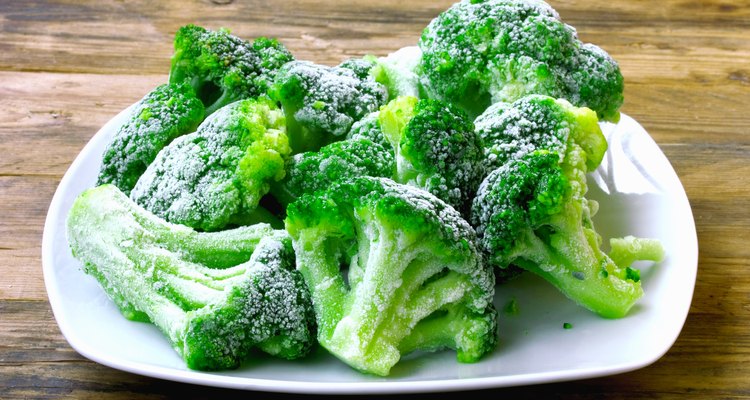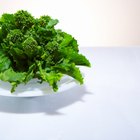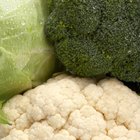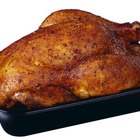
Xanya69/iStock/GettyImages
This Green Veggie is Fast, Convenient and, Most Importantly, It Won't Spoil
Broccoli is easy to cook and highly versatile, but fresh broccoli can be problematic if you have time constraints in the evening. After all, it takes time to separate the florets, and to peel and slice the stems, and that's time you might not have.
Frozen broccoli, on the other hand, is ready to use immediately and cooks in just a few minutes. It's a convenient replacement for those high-stress nights, with the added advantage that it won't turn yellow or mushy if you forget about it for an extra couple of days.
It's Just a Bit Different
The primary difference between fresh and frozen broccoli is that the frozen variety is already blanched – lightly cooked – so it doesn't take as long to reach your preferred doneness, whether that's tender-crisp or completely soft. It will also shed a bit more moisture than fresh broccoli, but almost any cooking technique you use with fresh broccoli will work with frozen:
- Microwave Method: Measure 2 to 4 portions of frozen broccoli into a wide, microwave-safe dish, and add a few tablespoons of water. Cover the dish with and microwave on high for 3 to 4 minutes. Lift the lid carefully with a fork or tongs, carefully avoiding the steam, and check if the broccoli is tender enough yet. If not, heat it for an additional minute at a time until it's done.
- Stovetop Steaming: Put 1/2-inch of water in the bottom of a pot, and then add your steamer insert. Cover the pot and bring the water to a boil, then add your frozen broccoli. Steam for 3 to 5 minutes, until the broccoli is tender.
- Simple Boiling: Bring a small saucepan of water to a boil over medium heat, then add your broccoli. Test the broccoli 2 to 3 minutes after the water returns to a boil; then every 30 seconds or so until it reaches the right degree of tenderness.
- Oven Roasting: Heat your oven to 425F. Arrange the frozen broccoli in a single layer on a parchment-lined baking sheet, and roast it for 8 to 10 minutes until the broccoli has thawed and its surface is dry. Remove the broccoli from the oven, spray it or toss it with vegetable oil, then return it to the oven for another 20 to 25 minutes until it's caramelized in spots and the tiny flower buds are crunchy.
- Stir-Frying or Sautéing: Have the pan hot before you add the broccoli. Do a small handful at a time, tossing or stirring it in the pan until it releases its moisture with a loud sizzle. Remove each handful at this stage, until you have as much broccoli as you need. Add it back to the pan or stir-fry, along with any other vegetables, and toss until it's as tender as you'd like.
Straight to the Dish
You don't always have to cook the broccoli separately. In many cases, it's fine to just add it to whatever you're already cooking. If you're steaming a pot of mixed vegetables, for example, you could add the broccoli just for the last few minutes of cooking time. Frozen broccoli can go straight into a casserole or a pot-pie filling, where it will have plenty of time to become tender in the oven.
If your kids will only eat broccoli when it's smothered in cheese sauce, a few minutes in the sauce will cook it quite effectively. Similarly, you can add frozen broccoli to good ol' mac and cheese as it cooks, adding color and nutrition to the kid-friendly staple.
Related Articles

How to Steam Broccoli Without Making it ...

How to Perfectly Cook Broccoli

How to Cook Romanesco Broccoli

Do You Cook Broccoli When You Put It on ...

How to Broil Broccoli

How to Eliminate Bitterness in Broccoli

The Impact of Cooking Broccoli

Do I Need to Steam Broccoli Before I ...

How to Freeze Broccoli

How to Freeze Fresh Asparagus

How to Cook Rice With Broccoli

How to Steam Cauliflower & Broccoli

How to Cook Cauliflower Without ...

How to Bake Broccoli in the Oven

How to Use the Steamer on the Showtime ...

Ways to Cook Kohlrabi

How to Broil Zucchini in the Oven

How to Boil Chayote

How to Cook Fresh Broccoli in a Slow ...

How to Dry Broccoli
Writer Bio
Fred Decker is a trained chef and prolific freelance writer. In previous careers, he sold insurance and mutual funds, and was a longtime retailer. He was educated at Memorial University of Newfoundland and the Northern Alberta Institute of Technology. His articles have appeared on numerous home and garden sites including GoneOutdoors, TheNest and eHow.